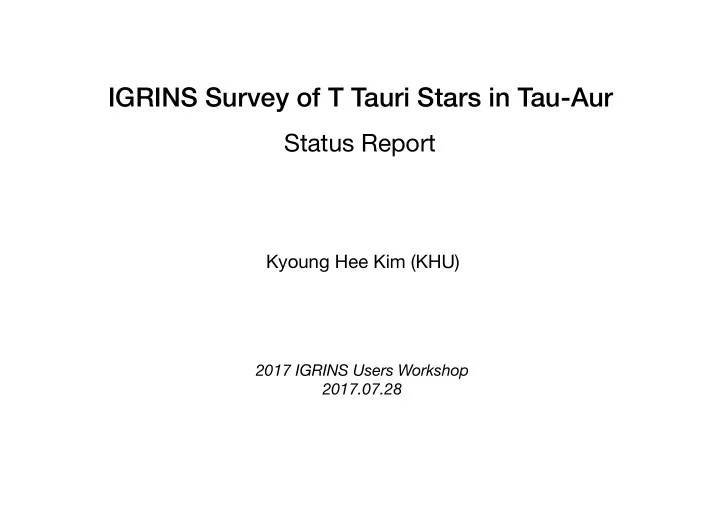

IGRINS Survey of T Tauri Stars in Tau-Aur Status Report Kyoung Hee Kim (KHU) 2017 IGRINS Users Workshop 2017.07.28
Star Formation & Young Stellar Objects Overview of star formation (Greene, 2001)
Dullemond+2010
Schematic picture of accretion in T Tauri stars Borrowed from Elisabetta Rigliaco’s homepage (orginally from Hartmann (2009))
Purpose of the program Goal: to understand the disk evolution and the effect of • planet formation in the accretion system via systematic studies using a large sample • Method: We measure properties related to mass accretion (e.g., veiling, mass accretion rate, radial velocity, magnetic field strength, other accretion tracers). (1) Accretion rates from Brackett lines. (2) Any trends of the disk properties (e.g., spectral index). (3) Line profiles of Br gamma. (4) Search correlations among other lines. (5) Investigate methods to figure out mass accretion activity and magnetic fields (use Ti I lines). (6) Eventually test magnetospheric accretion models.
Observation Status • Proposed: 126 Class II YSOs selected (Kmag < 11) + α • Observations: from Oct. 2014 to Jan. 2015 (UT/KASI/KHU) • 86 objects observed out of 126 – Single epoch: 56 – 2 epochs: 23 – 3 epochs: 3 – 3+ : 4 (CI Tau, DS Tau, DH Tau A, DO Tau) (Updated since IGRINS 2015 user meeting)
Reduction process (2015) Spectrum Extraction with PLP_v2.1 • IRAF: scombine, splot, telluric • Extract K band 12 th order (2.155~2.185µm) • Correct Br γ absorption of A0 Standard star’s • spectrum Telluric correction of target spectrum (adjust scale • factor and wavelength shift) • Normalize the telluric corrected target spectrum • Measure equivalent width (EW) of Br γ emission feature
From Br γ to dM/dt EW = F line /F cont • Adopted 2MASS K band magnitude as F cont • • Distance to Taurus, d=140 pc L Br γ = 4 π d 2 F line • (Muzerolle+1998)
Reduction Status • Reduction done by PLP 2.1-alpha4 (2015) and PLP 2.2-alpha1 (2017) • Keep Br γ analysis with the products after IRAF tasks (plp 2.1-alpha4) • 64: availa ble dM/dt right now – Adopted averaged dM/dt for multi epochs data for the current purpose – Median(dM/dt): 10 -7.7 M sun /yr (2.1 x 10 -8 M sun /yr) • others : too faint, very weak emission or very noisy, can’t fit; no available info of R*, M*, etc by now
Reproduction of the basic correlations M star , L star , R star , T e ff , and A v from Andrews+2013 (many from Furlan+2011) M disk from Andrews+(2005) (31/64 available) N=64 N=64 N=64 s=-0.1+-0.2 s=1.3+-0.3 s=0.9+-0.1 corr=-0.1+-0.2 corr=0.4+-0.1 corr=0.8+-0.1 correlated correlated no correlation! Disk masses to be updated w. recent observations (ALMA)
n(K-6), n(13-31), and EW(10) from Spitzer/IRS data N=58 N=58 no corr s=0.4+-0.2 s=-0.1+-0.1 no corr corr=0.4+-0.1 corr=0.1+-0.1 correlated tendency No noticeable trends between mass accretion rates and properties of outer disks N=64 Correlation s=0.14+-0.03 corr=0.5+-0.1
2MASS J, H, and K band magnitude (extinction corrected) N=63 N=63 N=63 s=-0.6+-0.1 s=-0.5+-0.1 s=-0.6+-0.1 corr=-0.94+-0.06 corr=-0.83+-0.1 corr=-0.97+-0.1 correlated correlated correlated The strength of the correlation increased from J to K. Why? Is this related to disk structures (gas and dust)? Could RADMC-3 continuum modeling help to understand it?
spectral index of 2MASS bands (extinction corrected) N=63 N=63 N=63 s=0.1+-0.1 s=0.2+-0.1 s=0.2+-0.1 corr=0.12+-0.13 corr=0.2+-0.13 corr=0.24+-0.14 It looks scattered, but focus on distribution between -1 and 1. Stellar contribution to J? Disk contribution to K (and H)?
Next: Examine Spectra gntau (20150126) dhtau (20141130) H 2 fztau (20141124) Br c Ti I H 2 1.4 Br c Ti I 1.2 1.15 H 2 Br c Ti I 1.1 1.2 1.10 1.10 1.15 1.2 1.1 1.6 1.10 1.05 1.10 1.05 1.0 1.0 1.1 1.4 1.00 1.05 1.05 1.0 1.00 0.8 0.95 1.0 1.00 0.9 1.00 1.2 0.95 0.9 0.95 0.90 0.95 0.9 1.0 0.6 0.90 0.8 0.90 0.85 2.119 2.120 2.121 2.122 2.123 2.124 2.162 2.164 2.166 2.168 2.170 2.220 2.222 2.224 2.226 0.90 0.85 2.119 2.120 2.121 2.122 2.123 2.124 0.8 2.162 2.164 2.166 2.168 2.170 2.220 2.222 2.224 2.226 2.119 2.120 2.121 2.122 2.123 2.124 2.162 2.164 2.166 2.168 2.170 2.220 2.222 2.224 2.226 1.2 1.1 1.2 1.1 1.0 1.1 1.0 0.9 1.0 0.8 0.9 0.9 0.8 2.300 2.305 2.310 2.315 2.300 2.305 2.310 2.315 2.300 2.305 2.310 2.315 3.0 1.3 1.3 2.5 1.2 1.2 2.0 1.1 1.1 1.5 1.0 1.0 1.0 0.9 0.9 0.5 0.8 0.8 0.0 0.7 2.360 2.365 2.370 2.375 2.380 0.7 2.360 2.365 2.370 2.375 2.380 2.360 2.365 2.370 2.375 2.380 ex) To figure out how to analyze dM/dt and other lines
Future Goal: Test Magnetospheric accretion models the magnetospheric accretions in a stable (left-hand panel) and an unstable (right-hand panel) regime Kurosawa & Romanova 2013
Summary • There has been no progress for last one and half year. • But, we have resumed IGRINS data analysis this summer. • It is early to make conclusions based on the current correlation analysis. • We need to refine correlations by dealing the variability and multiple system effects. • Utilizing other lines and modeling to trace and confine mass accretion features is necessary. • Radial velocity analysis will be followed soon. • We may develop an idea for a Gemini proposal.
Recommend
More recommend